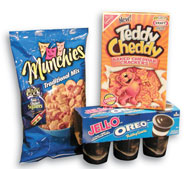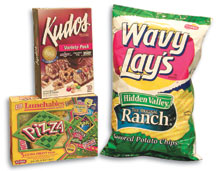

Battle of the Brands
Co-branding in the food industry is nothing new. General Mills (Minneapolis) added the Sun-Kist name to Betty Crocker lemon layer cake mix in the late 1960s, about the same time that Kellogg's (Battle Creek, Mich.) added Smucker's (Orrville, Ohio) fillings to Pop-Tarts. The partnership efforts hit a peak decades later when, in the early 1990s, a flurry of co-branded products raced onto store shelves. Some were successful, but others serve as prime examples of the dangers of co-branding.Delicious/Frookie (Des Plaines, Ill.) gained recognition in the mid-1990s with a line of cookies boasting brand-name peanut butters, Land O'Lakes (Minneapolis) butter and a different cookie of the week featuring a co-brand. The strategy would have been sound: the little-known company capitalizing on a relationship with an extremely well known brand. The problems surfaced on the package.
According to Elinor Selame, BrandEquity International (Newton, Mass.), “Delicious would shout the co-brand on their package design—that Planters or Hershey's were in these cookies. All the co-brand partners had strong recognition and strong brand assets. Delicious probably went to these companies and said, 'We'll use your products, but we want to shout it on our packaging.' They did and were the first in the food industry that started to do it very vigorously.”
Unfortunately, the company's own brand was completely overpowered by its famous counterparts. It failed to create and leverage a strong trademark on its packaging.
A successful co-branding effort—one that is beneficial to both sides—requires two strong brands in their own right. “That was the problem with Delicious,” Selame believes. “They were not well-recognized, nor did they try to make it a strong brand. They gave prominence to whomever was their invited guest. A company has to decide carefully if one brand should be highlighted or if they should share equal space, and if so, how do you do that in a great looking package design? What kinds of brands should get married to what kinds of brands? Not all of them are suited for each other.”
Ultimately, Delicious' endeavor netted only short-term gains. Often, such collaborations work in the short-run by increasing consumer awareness about a product. For true success, the product must answer a consumer need, and the participants must be compatible. It also helps if the pair target similar consumers and if the brands are held in roughly the same regard in their respective categories, i.e., two premium-quality items or two with lower price points.

Creating Co-dependence?
The selection of a co-branding partner is not to be taken lightly. Each participant risks its brand's integrity in the venture. As Mitch McCasland, founder of Brand Inquiry Partners (Dallas), notes, “If something happens to either participant, that will affect the co-branded product.” Furthermore, the impact could extend into each participant's respective other lines.When approached with an offer to co-brand, a company should research to understand the consumers of both companies, he says. “Make sure that they have the potential to enhance your brand by virtue of a positive association with another brand. Make sure the relationship is giving something residual to your brand, something that is going to stick around for a while.”
McCasland identifies a key problem with some past co-branding efforts. “Not testing it with consumers first. Not making sure there is a conceptual acceptance of the product. The association may seem to make sense and, in fact, benefit the brands in question. However, just because it sounds like a good idea does not mean it will garner the trust of the consumers to open their wallets.”
One such example never made it out of test market, although the concept seemed to be a natural. A peanut butter and jelly cracker featuring both Welch's and Skippy—properties of Welch Foods Inc. (Concord, Mass.) and Unilever Bestfoods Inc. (Englewood Cliffs, N.J.), respectively—went into test market and was rejected. Consumers reportedly found the product too confusing.
A (Co-)Brand New World
Consolidation within the industry has led to an increase in co-branding efforts, as a number of major companies have moved to leverage the power of their valued brands. For instance, Munchies combines the value of Frito-Lay's (Plano, Texas) Rold Gold name with Quaker Squares from Quaker Oats Company (Chicago). While leveraging the power of each brand, this endeavor ultimately benefits the owner of both—PepsiCo (Purchase, N.Y.).Such a collaboration is quite possible at jelly giant Smucker's, who debuted Uncrustables (a crustless, frozen peanut butter and jelly sandwich) last year before purchasing peanut butter baron Jif from Procter & Gamble (Cincinnati). However, such a maneuver requires careful thought, which applies to most co-brand opportunities.
“I would want to know the degree of market acceptance for that product,” says McCasland. “Why are the current Uncrustables consumers buying it? What were the values to them? (Uncrustables) is a very different concept. What kind of loyalty are people having to the concept? Does the product have legs? If so and there are no reasonable competitors out there, you have to evaluate the merits of introducing the Jif brand on top of that. If the consumer feedback is 'My kids don't like the peanut butter taste,' and Smucker's is using a privately manufactured peanut butter brand, then there might be an opportunity to address erosion of the loyalty or to enhance the product with 'Now made with Jif.' That becomes a clear decision if you have such feedback from the consumer.”
For her part, Selame does not believe timeliness (considering Uncrustables have been on the shelf for less than a year) is an issue. “It would not be too soon. It's a great combination. They own both. Both have strong brand names and strong recognition. They should go together, but they have to be careful with that co-branded package. Whose product is it? Who is the invited guest, and how do they combine the two in a design? It would be a great idea for them to try it, but it is a very serious proposition.”

Look at the Label
Typically, the host brand has the dominant position on the label. However, in some instances, the guest brand may appear larger on the label than the host brand, or both brands may be featured equally on the package. If it takes a lesser position, the host brand is making short-term financial gains but, essentially, is a hostage of the guest, Selame believes. “The guest brand is being built to be even stronger, while the host brand risks being left with a lesser-known brand when that guest leaves.”Such concerns have weighed heavily on major players who have expanded in recent years. In the wake of its acquisition of Nabisco, Kraft Foods (Northbrook, Ill.) found a number of synergies, as well as a number of opportunities to combine the array of powerful brands. “(Kraft's) push to achieve synergies extends to revenue opportunities, as well,” states Michael Polk, group vice-president of Kraft Foods North America and president of Nabisco Biscuit & Snacks Group. “There are, clearly, opportunities to bring some of our brands together to drive growth. In particular, Kraft brings tremendous cheese credentials to Nabisco. With Nabisco's cheese crackers, like Cheese Nips, there is opportunity to leverage Kraft's cheese equities to grow Cheese Nips. Also, Nabisco's snack cracker businesses have opportunities to leverage Kraft cheese and Oscar Mayer cold cuts in appetizer recipes.”
Furthermore, the Oreo brand is being leveraged in Kraft's dessert division. According to Margo Lowry, senior vice president of development with Kraft Foods North America, “A lot of interesting projects are going on in our Jell-O refrigerated ready-to-eat desserts. Our powdered dessert has been extended into a snackable area and created a category.” In addition, Kraft leveraged its Nabisco acquisition by introducing Jell-O Oreo pudding.
The opportunities are obvious, as well-done co-branding capitalizes on the strengths of each participant while attempting to negate the weaker aspects of each. Partnering with another brand can be an inexpensive way to garner attention, a lower-risk means of test marketing and can serve to make products less price-sensitive. In addition, it can provide a company with wider recognition. However, the strategy of such moves has left some in doubt.
“It could be a great opportunity,” says Selame, “but I'm not quite sure the companies are taking advantage of the possibility. If they do, it is crucial they determine how to co-brand visually. Who should take precedence on the package? In the supermarket, Nabisco came out with Kraft Cheese Nips, but when others and I looked at it in the supermarket, we didn't see Nabisco any more. Nabisco is a very proud brand, but now Kraft is so strong, the consumer hardly sees Nabisco.”
Selame warns of the possible consequences of such a move, for the result may be a cannibalization of the Nabisco brand and, finally, a deterioration and possible destruction of Nabisco's brand credibility among consumers. Co-branding does not have to toll a death knell for one of the participants, however. Each individual brand in any co-branding effort can survive and even prosper, if the end product and its marketing are handled carefully.
“These situations really need brand strategists to determine what to do after learning what the company wants to do,” Selame contends. “I think some companies have people designing the packages and not really thinking fully about the end result. 'What is going to happen in the future if we continue to do this? Will it be the future we want?'”
Website Resources
www.brandequity.com— BrandEquity Internationalwww.brandinquiry.com— Brand Inquiry Partnerswww.fritolay.com— Frito-Laywww.bestfoods.com— Unilever Bestfoodswww.smuckers.com— Smucker'swww.kraft.com— Kraft Foods
Sidebar: Joining the Service
Foodservice establishments know well the benefits of offering a familiar brand on their signature items. Try to find a restaurant without a dessert touting Oreos or another candy brand as an ingredient.The reasoning is simple—more variety equals higher visit frequency and, perhaps, larger checks. As Yum has learned, KFC is more of a dinner concept, while A&W has better lunch recognition. Pairing the two matches complementary day parts. Similar success has been found with Taco Bell and Pizza Hut, not to mention various other combinations of Yum's brands. Rumor has it that the company will soon roll out tri-branded restaurants, with three of their complementary concepts in one location.
When debuting the co-branded concepts, the restaurateurs were quick to portray each brand properly. Equal signage was important, as were furniture, décor and point-of-sale materials, as it was essential that this co-branding effort not appear to be a line extension. Each brand has to be represented in this concept in such a way that the identity of each is preserved.
In a similar co-branding effort, CKE Restaurants' (Santa Barbara, Calif.) Carl's Jr. chain has teamed with CKE's Green Burrito concept (Los Angeles) to offer American and Mexican fare. In the process, the pair has realized another benefit of restaurant co-branding; they take advantage of fixed expenses. However, such concepts must have the correct mix and proper training.
In test markets, Yum found that consumers preferred the co-branded concepts six to one, due to convenience and choice. As a Yum spokesperson notes, “It allows us to cover the veto vote. A family or a group of friends can go to one restaurant and get a combination of Mexican food or chicken.” Reports show Yum's co-branding efforts are netting results. Its 1,500 multi-branded concepts generated about $1.5 billion in sales, the company said.
Sidebar: Expanding the Co-branding
Notable recent co-branding efforts and some possibilities:Embassy Food Specialties Ltd. (Etobicoke, Ontario), a manufacturer of baking mixes and ingredients has teamed with Hempola Inc. (Barrie, Ontario), a developer and manufacturer of hemp food products. The line includes Hempola breads, pancake mix and brownie mix. The companies have plans to develop and launch many more products under the Hempola brand name.
Co-branding is particularly popular among ice cream products, incorporating ingredients from well-known candy, cookie, fruit and flavoring manufacturers. In addition, ice cream manufacturers have joined with popular coffee and chocolate brands to create premium products.
Dean Foods Co. (Dallas) is using the Land O'Lakes' (St. Paul, Minn.) brand name nationally on a range of value-added fluid milk and cultured dairy products, as well as on all basic fluid dairy products.
Selame believes co-branding with spices would be successful. For instance, McCormick & Co. Inc.'s (Sparks, Md.) spices could be in stuffing for turkeys or in a vegetable dish. “Also, some ethnic foods have great spices that many Americans do not know how to use.” In either case, the same rules for co-branding would apply. “The companies have to make it so that consumers understand the relationship between the two and want it because it is a great idea that maybe they had not considered.”
